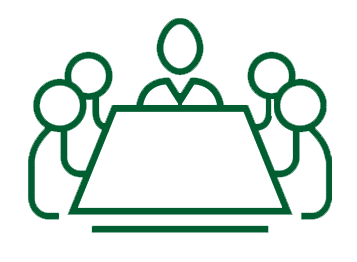Word on the street > On Capitalization, Taylor Swift, and Industry Leadership; Lead the Charge Against Fear and Resistance to AI in Your AE Firm
Word on the Street: Issue 196
Weekly real-time market and industry intelligence from Morrissey Goodale firm leaders.

On Capitalization, Taylor Swift, and Industry Leadership
“It’s a win-win proposition!” “There’s plenty of room for us all.” “Everyone’s a winner.” “There are no losers here.” Yeah, maybe. But it sure doesn’t look like that when it comes to the capitalization of the nation’s top design firms. Over the past decade, like slowly shifting geographic formations, the capitalization of the ENR Top 100 has been steadily morphing. One capitalization stratum has been expanding while simultaneously crowding out the two previously dominant layers.
- In the ascendant: We did a deep dive on the growing influence of the relatively new kid in town in last week’s Word on the Street article “The All-Pervasive Nature of Private Equity.” And sure enough, it’s in the ENR Top 100 that the dramatic growth of private equity (PE) can be most clearly seen. In 2016, just four of the top one hundred design firms had a private-equity backer. Today, that number is twenty-four—a six-fold increase in just nine years. In some of these design firms, PE holds a minority ownership position. However, in most, it’s the majority shareholder with control of the board of directors. There’s a misperception that PE is uniquely and exclusively suited for fast-growing engineering, construction services, or geotechnical/environmental services firms. That’s wrong. Some of the industry’s leading architecture (Populous, PBK) and surveying/mapping firms (SAM) have PE in their capital stack. The model has more than demonstrated its resiliency and viability over the past decade with multiple industry icons passing from one PE backer to another more suited to support the next level of growth. All told, this 24-firm cohort of PE-backed designers generated close to $12 billion in design services last year.
- A Taylor Swift moment for employee ownership: Breakups can be tough. Relationships change. Time moves on. So, is this the beginning of the end of the age-old partnership between industry leadership and employee ownership? In 2016, three-quarters of the top designers were employee-owned (a catch-all term for firms that are privately owned by either their employees, partners, a full- or partial-ESOP, or a family or other type of trust). Today, that number is less than two-thirds—its lowest point ever. Much like the ballyhooed “end of the mid-sized firm” theory from the noughties, there has been a lot of hot air recently around the demise of employee ownership in the AE industry. Safe to say, employee ownership is not going away any time soon. But, its viability as a preferred model among the leading design firms of the future is—based on the numbers—up for debate. Why are more and more leadership teams of the nation’s top firms electing to trade in their cherished employee ownership for PE? Is it because leadership and ownership transitions are hard? There’s some of that, for sure. Is it due to the industry being more competitive, requiring stronger balance sheets? Probably. Is it a result of the capital demands of new technologies? Possibly. Whatever the reasons—the employee-ownership model amongst leading designers is (a) in decline and (b) based on the inquiries we get on a monthly basis, under serious scrutiny for its continued viability. Is this an inevitable breakup? Or can the marriage be saved? And if so, when will things turn around and why? When will the number of employee-owned top designers start growing again? These are some of the questions that can be asked about the longer-term viability of the employee-ownership model among the leading design and environmental firms.
- The end of Goliath? If you think that PE-backed firms are increasing their position solely at the expense of previously employee-owned or ESOP firms, think again. For years, you could rely on about 20 publicly traded firms in the design and environmental consulting industry. Many of the “original” publicly traded giants (URS, Dames & Moore, The Keith Companies, Greiner Engineering) were acquired by larger, stronger publicly traded North American-based global brands along the way. However, on an annual basis, IPOs reliably replaced the numbers of design firms accessing the public capital markets, which maintained this relatively stable group of 20 or so. These giant publicly traded firms occupied positions among the top 100 designers. But over the past decade, slowly but surely, one-by-one, PE has been recapitalizing the industry’s publicly traded firms, including, for example, Atlas Technical Consultants in 2023, Aegion (now Azuria Water Solutions) in 2021, and TRC Companies in 2017.
A decade ago, if you wanted to work for one of the leading design firms in the U.S., you chose to go into the office of either an iconic employee-owned or publicly traded firm. Today, you’ve got three choices on which to hang your hybrid company-logoed baseball cap. And one of them seems to be elbowing out the other two.
M&A Best Practices Award application window closes this Friday: Applications continue to roll in for this year’s M&A Best Practices Award, which will be presented at the Western States M&A and Business Symposium at the luxe Wynn Hotel in Las Vegas, June 12-14. If you’d like your firm to be considered for the award and the industry recognition that comes with it, we invite you to complete the simple application form here. The application should take no more than 20 to 30 minutes to complete. The award recipient will be notified in early June.
To connect with Mick Morrissey, email him at [email protected] or text him at 508.380.1868.
Lead the Charge Against Fear and Resistance to AI in Your AE Firm
Artificial intelligence (AI) is reshaping industries worldwide. In the AE industry, AI has the potential to transform how we design, plan, and execute projects, offering enhanced efficiency, reduced costs, and new levels of creativity. However, some firm leaders remain hesitant to adopt AI, fearing that delegating tasks to AI might reveal gaps in their teams’ capabilities or lead to workforce displacement. In this article, we’ll explore why firm leaders should embrace AI, address common fears, and outline strategies for integrating AI into AE firm practices without compromising human value.
Fear of AI: A Leadership Perspective
For many AE firm leaders, resistance to AI stems from a mix of concerns. Some fear that AI’s efficiency might highlight inefficiencies in their existing workflows or even replace human talent. Others worry about the investment required to integrate AI into their practices, including the need for training and system upgrades. There’s also a concern about losing control over critical processes and potentially compromising the firm’s reputation if AI fails to deliver expected results.
Yet, these fears overlook AI’s true potential as a partner, not a replacement. Rather than undermining human roles, AI can free up valuable time for professionals to focus on what they do best: create, innovate, and build relationships with clients. The key for firm leaders is to understand how AI can complement and enhance their teams’ skills.
Leading the Charge: Why AI Is Essential for AE Firms
As a firm leader, embracing AI is about the sustainable use of human and financial capital, higher-quality deliverables and a superior client experience, long-lasting competitive advantages, and increased profitability. Here’s how AI can help accomplish these and related goals:
- By boosting efficiency and accuracy. AI can streamline processes, from data analysis to project management, allowing teams to work more efficiently and accurately. By automating repetitive tasks, AI reduces the risk of human error and frees up your employees to focus on higher-level design and problem-solving. This improved efficiency can translate into cost savings, faster project completion, and reduced employee burnout.
- By enhancing creativity and innovation. AI-driven tools like generative design and data analytics can inspire new approaches to architecture and engineering, as well as all of the functions that support this work. By analyzing vast datasets and exploring design possibilities, AI can spark creativity and help people develop innovative solutions.
- By enabling informed decision-making. AI provides firm leaders with data-driven insights that can guide decision-making throughout a project. Whether it’s optimizing resource allocation, identifying potential risks, or enhancing sustainability, AI can help people make grounded assessments and sound decisions.
- By facilitating collaboration. Programs that use AI create collaborative environments that can lead to smoother project execution and stronger relationships with clients.
Strategies for Embracing AI
To successfully integrate AI into your firm, consider the following:
- Get your feet wet. Start the journey by participating in workshops, tutorials, and masterclasses such as this leading AI course for AEC leaders offered by Morrissey Goodale’s AI partner, Thrivence. This kind of training can demystify AI and equip you to lead the effective use of AI tools throughout your organization.
- Start with small-scale projects. Begin experimenting by integrating AI into specific projects or tasks where its impact can be clearly seen. This gradual approach allows your staff to build confidence and understand AI’s benefits without feeling overwhelmed. As AI’s advantages become apparent, expand its use to broader areas within the firm.
- Promote a collaborative culture. Encourage collaboration between AI and human talent. Highlight that AI is a tool designed to augment human skills, not replace them. By fostering a culture that values teamwork and communication, you can ensure that AI enhances, rather than undermines, the work your firm does.
- Showcase success stories. Demonstrate AI’s value by showcasing success stories from within your firm and/or the broader AE industry. Share examples of how AI has improved project outcomes, reduced costs, or led to innovative designs. These stories can help alleviate fears and inspire your team to embrace AI’s potential.
AI is here to stay. Although it’s natural to have concerns about its impact, firm leaders must understand and accept that AI can be a valuable ally in fostering a work environment where employees can focus on their well-being and teamwork while delivering enhanced results for the firm and its clients.
Questions? Comments? Call or text Mark Goodale at 508.254.3914 or email [email protected].
Market Snapshot: Engineering and Construction Stocks Performance
The stock market has experienced some volatility over the last few years. More recently, the three main indexes have nearly reached record highs as the economy showed signs of cooling and corporate profits grew. We gathered a few insights specific to the engineering and construction industry, which is one of twenty-five within the industrials sector (as classified by the Global Industry Classification Standard).
- Engineering and Construction (E&C) has reached a nearly 24% return since the start of 2024, making it the fifth best-performing industry within its sector, which averaged 9.3%.
- Companies in E&C also outperformed the S&P 500’s year-to-date return of 9.5%. Over the last three years, E&C has had a return of over 71% compared to 23% by the S&P 500.
- According to Yahoo Finance, the total market cap for the E&C industry is about $209 billion and represents 3.8% of the industrials sector.
- Total revenue is $169 billion.
- There are 44 companies and 516,000 employees represented.
For the latest insights on U.S. regions and AE markets, check out our 2024 AE Market Intelligence Webinar. Click here to access recording and materials.
To learn more about market intelligence data and research services offered by Morrissey Goodale, schedule an intro call with Rafael Barbosa.
Weekly M&A Round Up
Another transaction in the Western U.S.: Last week we announced another deal in the West, this time in Montana. We reported six additional domestic deals in FL, GA, and MI. Overseas there were two deals in the UK. To learn more about M&A activity in this fast-growing region, join over 200 industry executives and investors from all across the West and beyond at the 10th annual Western States M&A and Business Symposium on June 12-14. You can check all the week’s M&A news here.
October 16-18, 2024 Houston, TX
Texas and the South M&A and Business Symposium
Over two-plus information-packed days, come together to discuss strategy, innovation, and M&A trends while networking with AE industry executives.
Learn More
AI & Innovation
Tap Into the Power of AI for your Firm
We’re partnering with the AI experts at Thrivence to bring AI Education and Business Solutions to the AE and environmental consulting Industry. Introducing a powerful 90-minute, on-demand AI Masterclass designed and delivered by CEOs for CEOs.

Searching for an external Board member?
Our Board of Directors candidate database has over one hundred current and former CEOs, executives, business strategists, and experts from both inside and outside the AE and Environmental Consulting industry who are interested in serving on Boards. Contact Tim Pettepit via email or call him directly at (617) 982-3829 for pricing and access to the database.
Are you interested in serving on an AE firm Board of Directors?
We have numerous clients that are seeking qualified industry executives to serve on their boards. If you’re interested, please upload your resume here.
Subscribe to our Newsletters
Stay up-to-date in real-time.











